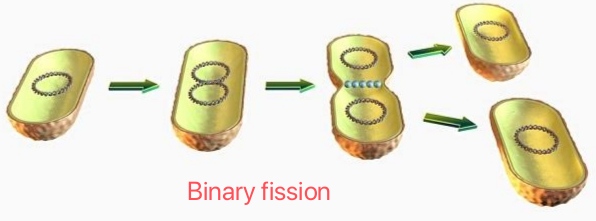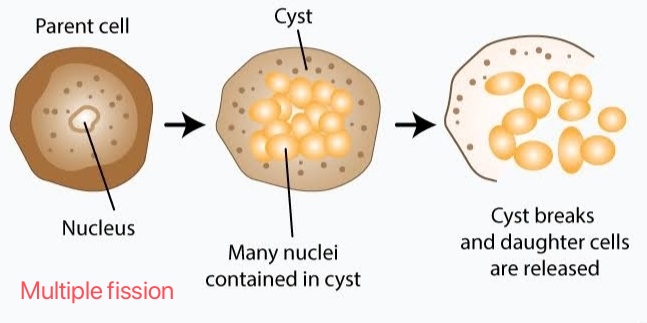Reproduction:
Reproduction is the process by which living organisms produce new individuals similar to themselves. It ensures continuity of life on earth
*Different types of reproduction:
There are mainly two types of reproduction sexual and asexual reproduction
*AsexualReproduction:
It is a mode of reproduction involving single parent. There are different modes of asexual reproduction:
1.Fission: it is defined as the splitting of the organism into two equal halves and each half give rise to a new organism for example, amoeba, bacteria
2.Binary fission: in this reproduction two cells are formed for example, amoeba,

3. Multiple fission: in this reproduction many cells are formed for example. plasmodium

4. Fragmenatation: it is a mode of a asexual reproduction in which organism breaks into pieces and each peace gives rise to a new organism for example, spirogyra, planaria

5. Regeneration: if organism is some how cut or broken into many pieces, each piece grows into a complete organism for example. Hydra

6. Budding: a bud is forrmed which develops into tiny individual. It detaches from parent body upon maturation and develops into new individual for example, yeast,Hydra etc

7.Vegetative propagation : In this form of reproduction stem roots and leaves are used to form plants when provided with suitable conditions. Layering and cutting are the two common methods used for vigitative propagation eg. Banana, roae, jasmine etc. The plant produced through vegetative propagation is genetically identical to parent plant.


8.Tissue culture: New plants are grown by using growing tip of a plant. These growing cells are kept in a culture medium leads to formation of callus.Callus is then transferred to harmone medium which causes growth differentiation eg, Ornamental plants orchid.
Benefits of tissue culture :
*We can grow plant is like banana rose etc that have lost the capacity to produce seeds.
*New plants are genetically similar to parents.
*Help us in growing seedless fruits.
9.Spore formation: it is another form of asexual reproduction that involves specific reproductive parts such is hyphae in rhizopus and blob-on-a stick structure in rhizopus are involved in reproduction.


Q. Sexual Reproduction:
Answer: Sexual reproduction involved two different parent organisms involving a male and female parent.
Significance of sexual reproduction:
Sexual reproduction is the source of variation. Mixing of two organisms give rise to new recombinants or variants. Sexual reproduction involves the meeting of gametes. This gametes are haploid in nature that is they have half set of chromosomes these gametes are formed show the process of meiosis. When male and female gamete each with haploid set of chromosomes combine they will form a diploid zygote. Zygote undergo repeated divisions to form a new organism.
Q. Sexual reproduction in flowering plants:

Flower is the reproductive structure found in angiospermus flower consists of sepals,petal, stamens and pistils
Types of flowers:
Bi sexual flower: both male and female reproductive parts are present Eg, Hibiscus,Mustard etc.
Unisexual flower: Either male or female reproductive part is present Eg, papaya,watermelon etc.
Pistil/Carpel: is the female reproductive structure which consists of swollen basil part ovary. Middle elongated style and terminal stigma. Ovary contain ovules and each ovule bear an egg cell.
Stamen: is the male reproductive part and it consists of anther and the stigma anther contain pollen grains which fuses with female gamete that is egg cell.Fusion leads to zygote formation which forms and new plant.
Transfer of pollen grain from the anther to the stigma of the flower is known as pollination.When the pollen and the stigma is of the same flower it is known as Self pollination. When pollen from one flower land on the stigma of another flower it is known as Cross pollination.

Process of seed formation:

* Pollen grains produced in the anther are transferred to the stigma of flowe through agent is like Air, water or Animals.
* Pollen grains germinate and form pollen tubes which passes through style to reach up to the ovules present in ovary.
* The fusion of male and female gametes is called fertilization.Zygote is produced inside the ovary.
* Zygote divided to form embryo. Ovule develops thick coat and changes into seed gradually.
* Ovary change into fruit and other parts of flower fall off.
* The seed germinate to form a plant under suitable conditions such as Air,Moisture etc.
Also Read: Class [10th ] Topic : The Respiratory System
Q. Male Reproductive system:

The male reproductive system consists of :
- Testicles /Testes: A pair of oval-shaped organs masked in a pouch called the scrotum. They are responsible for the production of sperms and the male hormone testosterone.
- Scrotum: It is a sac-like organ that hangs below the penis and behind it. It is the houses of the testicles, or testes, and maintains a temperature that is required for the production of sperm by it.
- Seminal Vesicles:These are sac-like pouches which are linked to the vas deferens close to the bladder base. The fluid contained in the seminal vesicles are responsible for making up the maximum volume of a male’s ejaculatory fluid.
- Vas deferens: The sperms produced in testes are stored in a tube called the epididymis. Here the sperms get matured and pass to urethra through the muscular tube called vas deferens.
- Accessory glands: This includes three glands, namely seminal vesicles, prostate gland, and Cowper’s gland. The secretions from the three glands mix to form a fluid called semen. Semen nourishes the sperm, increases the volume and helps in lubrication.
- Ejuculatory Duct: The ducts are formed due to the union of the seminal vesicles and vas deferens. Ejaculatory ducts gets unfilled into the urethra.
- Prostate Gland:It is a walnut-sized assembly which is present under the urinary bladder. The function of the prostate gland is to contribute additional fluid for ejaculation.
- Urethra: It is a tube which carries urine starting from the bladder to travel outside the body.
- Penis: Penis is a cylindrical tube which serves as both reproductive organ and an excretory organ. It delivers sperms into the vagina during sexual intercourse.
Q. Female Reproductive System
Answer: The female reproductive system is active before, during and after fertilization as well. It consists of the following parts:
- A pair of ovaries: Ovaries produce and store ovum in them. They also produce a female hormone called estrogen.
- Fallopian tubes (Oviducts): They are the site of fertilization. They connect ovaries with the uterus.
- Uterus: Uterus is the site of development for the embryo.
- Vagina: It is the part which connects the cervix to the external female body parts. It is the route for the penis during coitus as well as a fetus during delivery.

Female reproductive system has two functions –
- Production of female gamete called ovum/egg.
- Providing nutrition and protecting the developing embryo.
During puberty, eggs in the ovaries start to mature. One of the ovaries releases the matured ovum in every 28 to 30 days and is called ovulation
Also Read: Our Environment
Q. Reproduction Process in Human Beings.
Answer: The process of fusion of sperm with egg (ovum) to produce zygote is called fertilization. Fertilization is a crucial stage of reproduction in human beings. The fertilized egg is called the zygote. Zygote starts to divide into many cells and develops into an embryo.Embryo moves into the uterus and gets attached to its walls. This process is referred to as implantation, and the implanted embryo eventually develops into a fetus.
Q. What is Fertilization?
Fertilization is the fusion of male and haploid female gametes (egg and sperm) resulting in the formation of a diploid zygote.
Q. What is Cell Differentiation?
Cell Differentiation is the process through which a young and immature cell develops into a specialized and matured cell.
Q. What is Parturition?
Parturition is the process of delivering the baby after the completion of pregnancy or a fully grown developed fetus and placenta from the uterus to the vagina to the outside world. This process occurs in three stages, which includes:
- Stage 1: Preparatory Stage- 2 to 12 hours.
- Stage 2: Birthing Process –30 to 180 minutes.
- Stage 3: Placenta Expulsion –1 to 12 hours.
Also Read: Control and Coordination
Q. Difference between sexual and asexual mode of reproduction?
Answer: Both sexual and asexual are two different modes of reproduction. Sexual mode reproduction takes place in all multicellular organisms including humans, animals, and higher plants. Asexual mode reproduction occurs only in lower invertebrates and other simpler living species such as amoeba, bacteria, and hydra.
Menstruation occurs due to the rupture or removal of the inner, thick, and soft lining of the uterus when fertilization does not take place.
Q. Menstrual cycle or Mensuration cycle
Answer: The menstrual cycle of a female is as follows:
- After a female attains puberty, every month one of the ova of the ovary matures and gets released once every 28 days (on an average) by the process of ovulation.
- The lining of the uterus becomes thick and spongy before ovulation in order to implant the fertilized egg. If the egg is not fertilized, this lining of the uterus breaks and comes out of the vagina along with the unfertilized egg which is known as menstrual flow.

